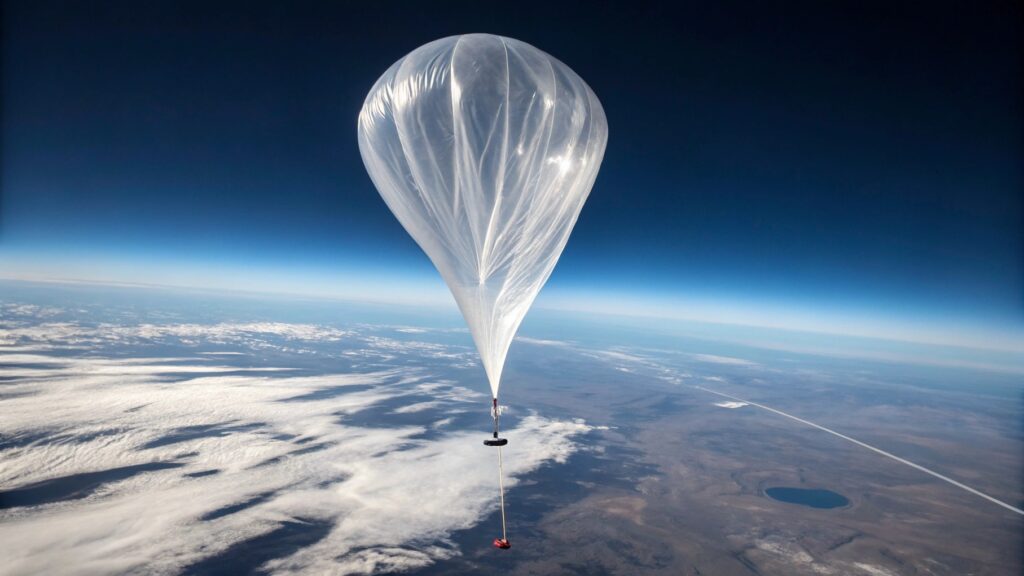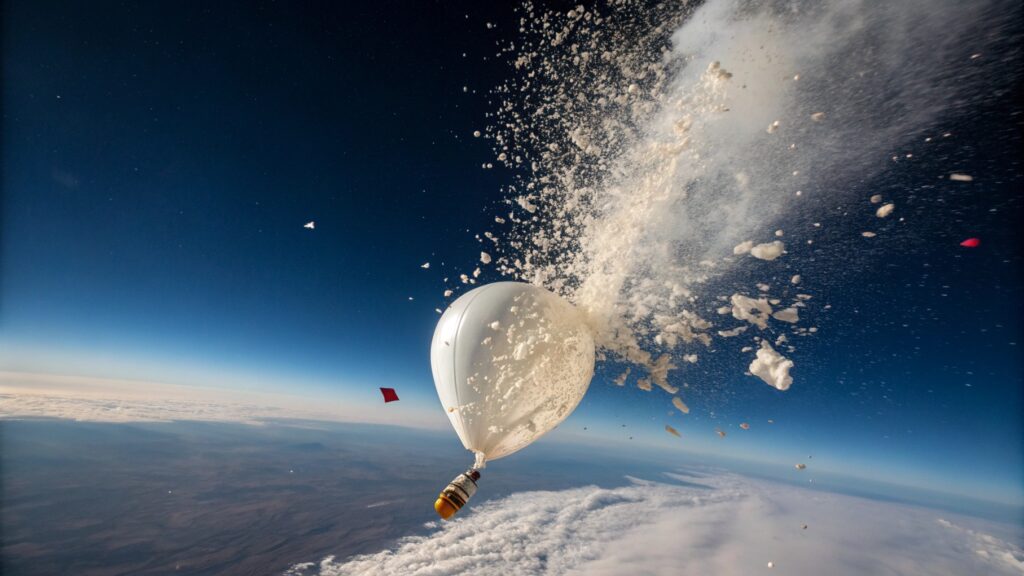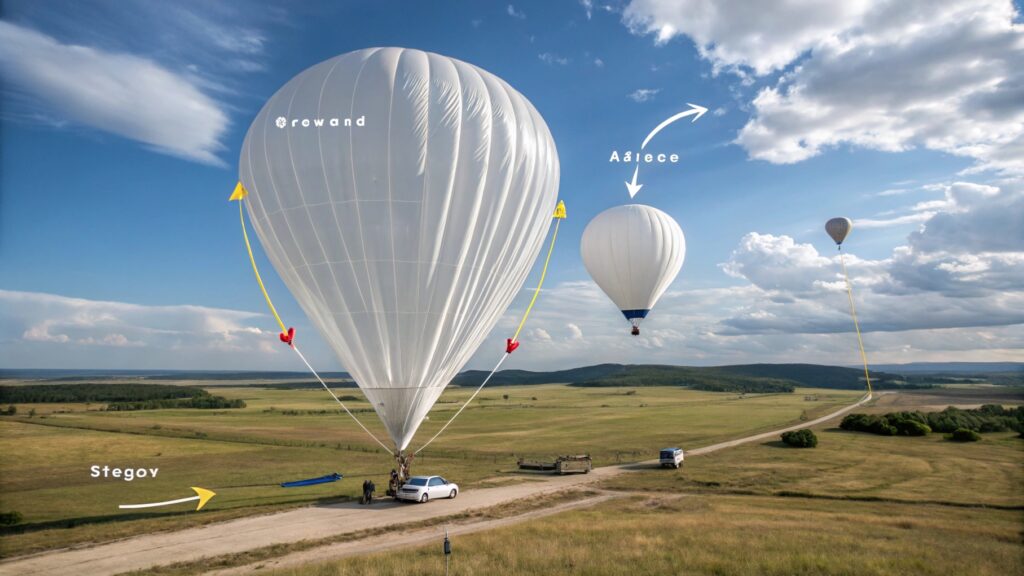If a helium balloon flies away, does it reach space?
Do you ever wonder what happens to a helium balloon when it escapes your grasp and floats into the sky? Many of us have watched balloons disappear into the clouds, imagining them drifting endlessly upwards. But do they truly reach the vast emptiness of space?
A helium balloon cannot reach space because it will eventually burst due to changes in atmospheric pressure1 as it ascends. The balloon expands as it rises, reaching a point where the internal pressure exceeds the strength of its material, causing it to pop.

It's a common childhood fantasy, seeing a balloon soar higher and higher, disappearing from view. But the reality is far more interesting and grounded. This journey isn't endless; it's a scientific adventure with a predictable end.
Does a helium balloon stop rising when it reaches the stratosphere?
Have you ever considered what happens when a balloon reaches extreme altitudes, like the stratosphere? Many people assume balloons just keep going up forever, or maybe they just stop. The truth is, their journey is much more dramatic.
A helium balloon does not simply stop rising when it reaches the stratosphere. Instead, as it continues to ascend into thinner air, its gas expands, causing the balloon to grow larger. This expansion eventually leads to the balloon bursting2 due to the pressure difference.

When a helium balloon goes up, it enters different layers of Earth's atmosphere. Each layer has unique properties, especially related to air density and temperature. This affects how the balloon behaves.
Understanding Atmospheric Layers and Balloon Behavior
As a helium balloon ascends, it passes through several atmospheric layers3, each with distinct characteristics that influence the balloon's fate. Understanding these layers is key to knowing why a balloon cannot reach space.
| Atmospheric Layer | Approximate Altitude Range | Key Characteristics | Impact on Balloon |
|---|---|---|---|
| Troposphere | 0 - 12 km | Densest layer; weather occurs here; temperature decreases with altitude. | Balloon rises quickly due to density difference; air resistance is highest here. |
| Stratosphere | 12 - 50 km | Contains ozone layer; temperature increases with altitude. | Air is much thinner; balloon expands significantly; temperature variations affect material. |
| Mesosphere | 50 - 85 km | Coldest layer; meteors burn up here. | Very thin air; most balloons burst before reaching this layer due to extreme expansion. |
| Thermosphere | 85 - 600 km | Very thin air; high temperatures due to solar radiation. | No balloon can reach this layer intact; material would already have failed. |
The main reason a helium balloon eventually bursts is the pressure difference4 between the inside and outside of the balloon. As the balloon rises, the external atmospheric pressure decreases significantly, but the amount of helium inside the balloon remains constant. This causes the helium to expand, pushing outwards on the balloon material. The balloon keeps expanding until its material can no longer withstand the internal pressure, leading to a burst. This typically happens in the lower stratosphere, well before it reaches the mesosphere or higher.
Can a helium balloon escape the Earth's atmosphere?
Have you ever considered if a helium balloon can truly escape Earth's atmosphere5, drifting off into the cosmos? It's a fun thought, but the reality is quite different. The laws of physics decide a balloon's ultimate fate.
A helium balloon cannot escape Earth's atmosphere and reach space. As it ascends, the decreasing external air pressure causes the helium inside to expand. This expansion inevitably leads to the balloon bursting at a certain altitude, long before it can leave the atmosphere.

The idea that a balloon might just float away forever often comes from how easily they rise from the ground. But the higher a balloon goes, the more the surrounding environment changes. These changes are exactly what prevent a balloon from ever leaving our planet's embrace.
The Science Behind Balloon Bursting at High Altitudes
The primary reason a helium balloon cannot escape Earth's atmosphere6 is the fundamental principle of gas expansion7. When you release a helium balloon at sea level, the air pressure around it is relatively high. As the balloon ascends, the surrounding atmospheric pressure8 drops considerably. Imagine the air as a giant cushion pressing on the balloon. As that cushion gets thinner, the helium inside the balloon, which maintains its original amount, has less external pressure pushing back on it.
This lower external pressure allows the helium gas to expand. The balloon's material, whether latex or Mylar, is designed to stretch only so much. As the gas expands, it continues to push outwards on the balloon's surface. Eventually, the elastic limit9 of the balloon material is reached. At this point, the balloon can no longer contain the expanding gas, and it ruptures or bursts. This event typically occurs at altitudes ranging from 8 to 25 miles (13 to 40 kilometers), which is still well within the Earth's atmosphere, specifically the stratosphere or lower mesosphere. Even the most robust scientific balloons designed for high-altitude research are built to withstand immense expansion but still burst or are released to fall back to Earth, never truly escaping the atmosphere. My experience shows that we design balloons to be durable, but even our best still adhere to these physical limits.
What happens to a helium balloon as it ascends to high altitudes?
Have you ever thought about the incredible journey a helium balloon takes as it climbs higher and higher? It's not just a simple rise; it's a sequence of changes influenced by the very air it travels through. What exactly does a balloon experience on its way up?
As a helium balloon ascends to high altitudes, the external atmospheric pressure decreases significantly, causing the helium gas inside the balloon to expand. This expansion makes the balloon's volume increase, stretching its material until it reaches its elastic limit and bursts, typically in the stratosphere.

The ascent of a helium balloon is a dynamic process. It's a constant battle between the internal pressure of the helium and the external pressure of the atmosphere. This ongoing interaction ultimately determines the balloon's fate.
The Trajectory and Fate of a High-Altitude Balloon
The journey of a helium balloon is directly shaped by the changing conditions of the atmosphere. The key factors that dictate its trajectory and eventual fate are pressure, temperature, and wind.
| Factor | Impact on Balloon Ascent | Resulting Event |
|---|---|---|
| Pressure | As altitude increases, external atmospheric pressure decreases. This allows the constant volume of helium inside to expand significantly. | The balloon expands until its material can no longer withstand the internal pressure, causing it to burst. This is the primary reason balloons don't reach space. |
| Temperature | Temperature generally decreases with altitude in the troposphere, then increases in the stratosphere. Extreme cold can make balloon material brittle. | While not the primary cause of bursting, very low temperatures can make certain balloon materials (like latex) less flexible and more prone to cracking. Cold also affects gas density slightly. |
| Wind | Wind speeds and directions change dramatically with altitude. The jet stream, for example, can carry balloons hundreds of miles. | Once a balloon bursts, its remnants fall back to Earth. The direction and distance of its fall are determined by prevailing winds at various altitudes. |
Once a balloon bursts, its fragments, along with any attached string or weights, fall back to Earth. The path they take depends entirely on the wind currents10 at different altitudes. This is why we at AIHUA BALLOON always emphasize using eco-friendly materials11. Our goal is to minimize any environmental impact from balloon events. We want to ensure that if a balloon does burst and fall, it decomposes safely, leaving no lasting harm. This commitment to sustainability is very important to me, as Vincent, and to our entire company.
How high can a Mylar or latex balloon realistically fly?
Have you ever wondered just how high those shiny Mylar balloons or classic latex balloons can actually go? We see them float away, but what's their true altitude limit? The answer reveals a lot about their design and the science behind their flight.
A typical latex helium balloon can realistically fly to an altitude of about 5 to 10 miles (8 to 16 kilometers) before bursting. Mylar balloons, being less elastic, generally reach slightly lower altitudes, often around 3 to 7 miles (5 to 11 kilometers), also bursting due to internal pressure expansion.

The type of material a balloon is made from plays a crucial role in how high it can ascend. Different materials have different properties, especially when it comes to flexibility and strength under changing pressures.
Material Differences and Altitude Limits
The two most common types of balloons are latex and Mylar, and their material properties directly influence their maximum altitude. Understanding these differences helps explain why one might fly higher than the other, and why neither can reach space.
| Material | Key Properties | Elasticity | Typical Burst Altitude (Approximate) | Reason for Burst |
|---|---|---|---|---|
| Latex | Made from rubber, flexible and highly elastic, biodegradable (especially natural latex). | High | 8-16 km (5-10 miles) | Stretches significantly as helium expands but eventually reaches its elastic limit and ruptures. |
| Mylar | Made from metallized nylon, less elastic and more rigid. Known for retaining helium longer at lower altitudes. | Low | 5-11 km (3-7 miles) | Does not stretch much; internal pressure quickly builds up with decreasing external pressure, causing seams to fail or material to tear. |
My experience at AIHUA BALLOON has shown me that the construction and quality of the balloon material are paramount. While a latex balloon stretches more and therefore can ascend higher before bursting, a Mylar balloon is more rigid but seals helium better for longer display times at ground level. Both, however, are subject to the same physical laws of gas expansion. Neither material can withstand the extreme pressure differentials found at truly high altitudes needed to reach space. The ultimate fate for both is a burst, followed by a fall back to Earth. This is why our focus is always on making moments colorful with safe, and wherever possible, environmentally responsible products. We understand the physical limits and design our balloons with those in mind.
Conclusion
A helium balloon will not reach space; it will ascend until the internal and external pressure difference causes it to burst, eventually falling back to Earth. This is why we champion eco-friendly balloons.
-
Learn more about atmospheric pressure and its impact on balloons, which is crucial for understanding their flight. ↩
-
Learn about the physics of balloon bursting and the effects of pressure changes in the atmosphere. ↩
-
Understanding atmospheric layers is crucial for grasping how they affect various phenomena, including balloon behavior. ↩
-
Learn about the science of pressure differences and how they impact the expansion and bursting of helium balloons. ↩
-
Discover the reasons why helium balloons cannot escape Earth's atmosphere and the physics behind it. ↩
-
Discover the reasons why helium balloons cannot escape Earth's atmosphere and the physics behind it. ↩
-
Learn about the principles of gas expansion and how they impact the behavior of balloons in the atmosphere. ↩
-
Discover how changes in atmospheric pressure influence balloon dynamics and their ability to rise. ↩
-
Find out how the elastic limit of balloon materials determines their capacity to withstand pressure changes. ↩
-
Investigate how wind currents influence the descent of balloon fragments after bursting, crucial for environmental considerations. ↩
-
Explore eco-friendly balloon materials that minimize environmental impact, aligning with sustainable practices. ↩
